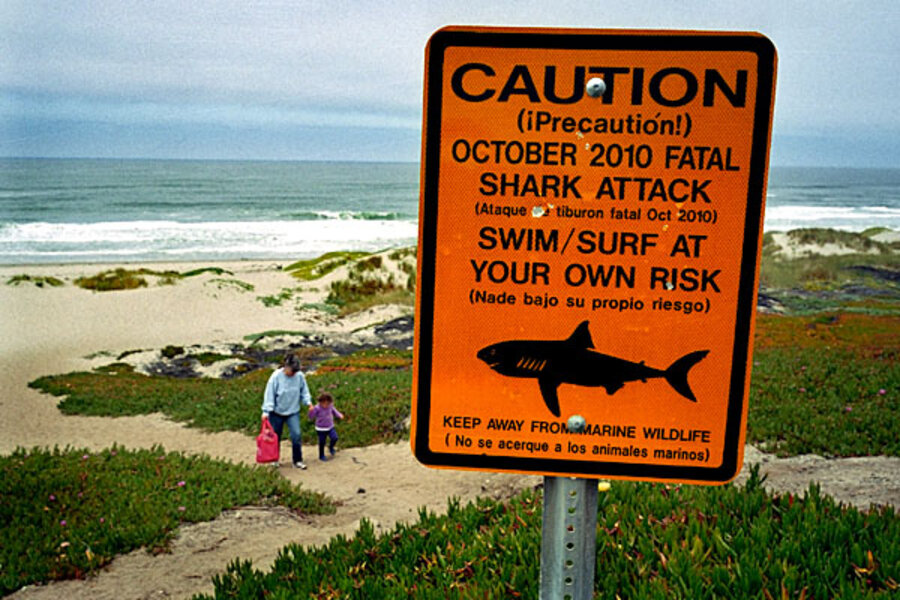California shark attack: Why so many great white encounters this year?
Loading...
| Los Angeles
A fatal shark attack off the coast of California Tuesday is raising fresh questions about an uptick in encounters between white sharks and humans along the West Coast and beyond.
Officials are investigating the bite marks in the torso of a man killed at a popular swimming spot near Vandenberg Air Force Base to determine the species of shark in the attack, but experts have suggested that it is almost certainly a great white.
The death is the 13th in California waters since 1950, but the fifth since 2003. That increased rate of fatal attacks, combined with an increasing number of great white sightings this summer on both coasts, has led to speculation over what is behind the increased interface.
The answer is, for now, unclear. Some scientists say better management of the commercial fishing industry has led to a substantial increase in the white shark population. Others suggest that the increasing number of people surfing, swimming, and kayaking has created new opportunities for white sharks and humans to cross paths.
But many experts agree that smartphones are giving people unprecedented ability to record white shark encounters – adding to the attention these encounters receive – and they say the pattern of attacks and sightings fits well into their understanding of the shark's seasonal migrations.
Above all, they agree that data show white shark attacks remain exceedingly rare, and the threat posed by them is small.
The issue first gained attention in July, when a white shark bit a kayak off Santa Cruz, Calif., throwing the man out of his boat. He was unhurt. The same week, a white shark was photographed trailing a kayak off Cape Cod, though it never attacked.
The Cape saw a record number of white shark sightings this summer. Likewise, officials in Santa Barbara, Calif., have been surprised at the number of white-shark sightings.
“It’s very unusual to see this many white sharks in our area,” Mick Kronman, harbor operations manager with the city’s Waterfront Department, told Noozhawk, a local news website. “They’ve been really close.”
Santa Barbara officials responded by posting warning signs at beaches for the first time. Cape Cod officials are currently discussing how to handle the situation.
On the Cape, a growth of the seal population is seen as bringing more white sharks, which feed on the seals. Similar dynamics could be in play off the California coast. The sightings here could signal that marine ecosystems are becoming more healthy after the passage laws targeting overfishing, such as the Marine Mammal Protection Act of 1972 and a ban on near-shore gill nets in 1994.
According to one estimate, there could be a few as 300 white sharks in California waters. But whether that represents an increase, decrease, or steady number is virtually impossible to know.
“We can’t know what low means because we don’t know how many there were prior to human fishing pressure,” says Chris Lowe, a marine biologist at California State University, Long Beach.
He suggests that the number of white sharks off California has increased significantly in recent years. “They’ve made a comeback bigger than most biologists would imagine,” he says.
But Andrew Nosal of the Scripps Institution of Oceanography in La Jolla, Calif., told the Los Angeles Times that he attributes the increased interface between humans and white sharks more to human activity.
What is more certain is the seasonal regularity.
Pacific white sharks hang out in what is known as the “White Shark Café” about 1,000 miles off shore for about six months of the year and then head for the Baja Peninsula. The migration takes about three weeks of swimming high speed for 50 miles per day, leaving them famished when they arrive near land. As they move northward throughout the summer and autumn into California waters, they're scouring the coastline where their prey lives – and where humans frolic.
“There is most definitely a seasonal pattern to this,” says Sal Jorgenson, senior researcher at the Monterey Bay Aquarium.
Despite all this, white sharks pose no serious threat to humans, says Dr. Lowe. “More people are killed driving to the beach, and yet we all take that risk.”







